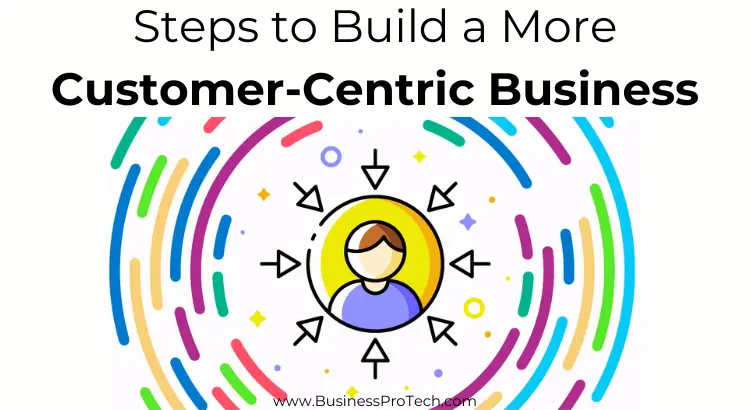In today’s competitive marketplace, businesses must prioritize the needs and preferences of their customers to stay relevant and successful. A customer-centric approach focuses on delivering exceptional experiences, anticipating and fulfilling customer needs, and building long-lasting relationships.
To build a more customer-centric business, several key steps must be taken. Let’s explore these steps in detail:

Understand Your Customers
The first step in building a customer-centric business is understanding your customers deeply. You do this by conducting deep market research, preferably through a specialized market research platform. Analyze customer data and gather feedback through surveys, focus groups, and social media interactions.
Identify your target audience’s demographics, preferences, pain points, and purchasing behaviors, and use them to create a buyer persona. When you know your customers’ pains, interests, and values, you can tailor your marketing efforts to meet those needs better.
Map the Customer Journey
Map out the customer journey from initial awareness to post-purchase support. Identify each touchpoint and interaction that a customer has with your brand across various digital marketing channels and stages of the buying process. This includes online interactions such as website visits, social media engagement, email communications, and offline interactions such as in-store visits and customer service interactions.
By mapping the customer journey, you can identify opportunities to improve the customer experience and address pain points.
Focus on Customer Experience
Building a customer-centric business aims to ensure customers have an excellent experience with your brand. But you cannot do it alone. Since your customers will often get to meet your employees, who will create either a positive or negative impression, you must invest in training your employees to provide excellent customer service and empower them to go above and beyond to meet customer needs.
Additionally, streamline processes and remove friction points to make it easy for customers to interact with your brand and make purchases. 65% of customers said they have changed to a different brand because of a poor experience.
Personalize Interactions
Personalization is key to building meaningful connections with your customers. Use customer data and insights to personalize marketing messages, product recommendations, and promotions based on individual preferences and behaviors.
Leverage marketing automation tools and customer relationship management (CRM) systems to segment your audience and deliver targeted communications at the right time and through the proper channels. Personalizing interactions can make customers feel valued and understood, increasing loyalty and satisfaction.
Collect and Act on Feedback
To build a customer-centric business:
- Actively seek feedback from your customers at every touchpoint.
- Encourage customers to share their thoughts, opinions, and suggestions through surveys, reviews, and social media interactions.
- Use this feedback to identify areas for improvement and make necessary changes to enhance the customer experience.
Respond promptly to customer inquiries and complaints and proactively address recurring issues. By listening to your customers, you demonstrate that their opinions are valued and that you’re committed to delivering a superior experience.

Measure Customer Satisfaction and Loyalty
To gauge the effectiveness of your customer-centric initiatives, track key performance indicators (KPIs) such as Net Promoter Score (NPS), customer satisfaction scores (CSAT), and customer retention rates.
With these metrics, you’ll see if you’re doing well or where lapses exist. Monitor trends over time and benchmark your performance against industry standards to identify areas of strength and areas for improvement. Use insights from these metrics to refine your strategies and prioritize initiatives that significantly impact customer satisfaction and loyalty.
Iterate and Adapt
Building a customer-centric business is an ongoing journey that requires continuous iteration and adaptation. To stay caught up, you’ll want to remain agile and responsive to changing customer needs, market trends, and competitive dynamics.
Regularly review and update your customer-centric strategies and initiatives based on feedback, data insights, and performance metrics. Additionally, try experimenting with new approaches, technologies, and channels to find what’s best for delivering innovative solutions that delight your customers.
Cultivate a Customer-Centric Culture
Finally, foster a customer-centric culture throughout your organization by instilling a shared commitment to putting customers at the center of everything you do. Communicate the importance of customer satisfaction and loyalty to all employees and departments, from frontline staff to senior leadership. Your employees are critical to how your customers perceive your brand. One rude employee can cost you hundreds of customers and thousands of dollars. Remember that.

You create a unified, customer-focused workforce that drives sustained business success by embedding a customer-centric mindset into your organizational culture.
The Bottom Line
Building a more customer-centric business requires a holistic approach that encompasses understanding customer needs, delivering exceptional experiences, collecting and acting on feedback, and fostering a customer-centric culture.
Suppose you follow these steps diligently and prioritize the needs and preferences of your customers. In that case, you can differentiate your brand, build stronger relationships, and drive long-term growth and success in today’s competitive marketplace.